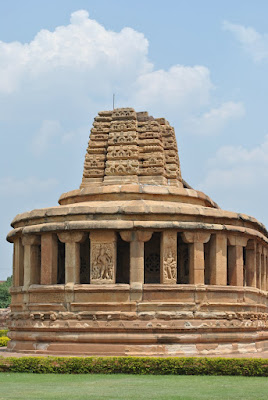Be it a metro dotted with skyscrapers and malls or a dusty little village in the hinterland, you can be sure that you are never too far away from a temple in India. Some of these majestic structures have withstood the ravages of time for centuries and still stand tall and proud. Have you ever wondered when and where our ancestors discovered, honed and perfected their skills in art and architecture thereby permitting us to gaze proudly at these temples today? To answer these questions and also have some fun along the way, I set out to North Karnataka with a few of my friends hoping to travel through the ages into the very beginning of known Indian History.
Badami, Aihole and Pattadakal form the historical trio of places where the art of building temples and rock carvings flourished right from 5th century AD. Badami is located around 500 kms from Bangalore and is accessible by train and bus. Aihole is around 40 kms from Badami and Pattadakal is midway between them.
 | |
| Durg Temple |
Aihole:
Aihole was the first capital of the Chalukyas and was called Aryapura in its earlier days. It was supposed to have been renamed Aihole after a woman found Parashurama, the Kshatriya(warrior clan) killer, washing his bloody axe in the lake and exclaiming “Ayyo-Hole”(the lake)!! Doubtless we will never know why and when Aryapura became Aihole since in our nation mythology is sometimes indistinguishable from history.
Aihole is supposed to the “Cradle of Indian Architecture” and has around 125 temples and a few caves. At the entrance of the complex is the horse-shoe shaped durg temple. This temple is supposedly the inspiration for the famous Konark temple in Orissa. Aihole has temples for both the main Hindu deities- Vishu, the protector and Shiva, the destroyer. Even though the Chalukyans worshipped Vishnu, prominence was given to Shiva as well indicating presence of both Shaivism(Worship of Shiva) and Vaishnavism(Worship of Vishnu) school of thought.
 |  |
| TriBangi Shiva | HariHara - Vishnu/Shiva |
The Tribanghi Shiva, Vijaya Narasimha, Mahishasure Mardhini and Harihara(Half-Vishnu Half-Shiva) are some of the notable sculptures. The Ladkhan temple in the structures dates back to the 5th century. Interestingly the sculptors were given the freedom to paint a true picture of those times. One sculpture shows an elephant crushing a condemned man to death. Another set of carvings show a couple cozying up before marriage and fighting it out after. Clearly the sculptor must have drunk deeply from the cup of life!
No comments:
Post a Comment